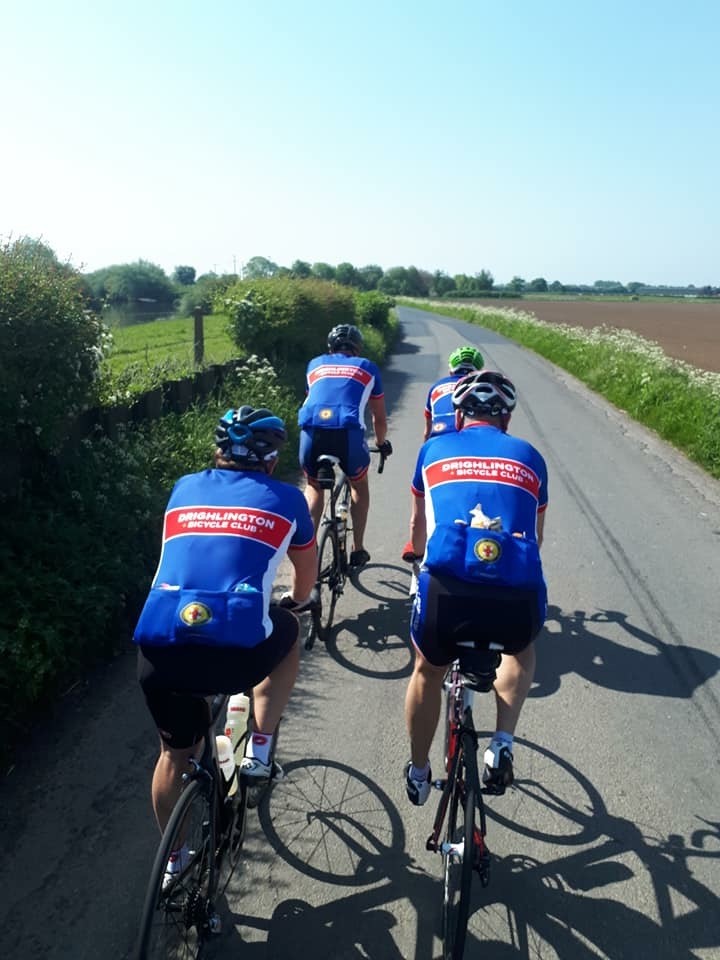Group Riding Etiquette

Indicating for a hazard
In this instance the front rider is indicating that there is a hazard in the road with the potential to damage a bicycle wheel, cause a puncture or an accident. In this case the hand signal may be accompanied with the warning “Inside” as the hazard is located between inside rider and the gutter.
When riding two abreast the front riders may split around the hazard and shout the warning “middle”, in this case both riders may indicate the location with hand movements pointing down between the pair.

Indicating for a left or right hand turn
The front rider is indicating the need to conduct a left hand turn, this signal will be accompanied with the command “Left” to gain the attention of riders to the rear. It is essential that the hand signal is repeated back through the group of riders and that the rear rider indicates the intended manoeuvre to any following vehicles.
When turning right, the signals and commands may come from the rear of the group, in this case it is essential that the rear riders ensure the road behind is clear of vehicles and that it is safe for the group to move across the carriageway.

When to ride two abreast
In general as a group it is safer to ride two abreast, the group of riders are more visible to all road users as well as being more compact and often easier for passing vehicles to overtake.
This formation can also commit passing vehicles to allow more clearance when overtaking as they have to ensure the oncoming lane is fully clear.
Highway Code Rule 66: Be considerate of the need of other road users when riding in groups. You can ride two abreast and it can be safer to do so, particularly in larger groups or when accompanying children or less experienced riders. Be aware of drivers behind you, and allow them to overtake (e.g. by moving into single file or stopping) when you feel it is safe to let them do so.

When to ride in single file
Here riders have changed to single file, the ride captain may shout “single up”. This can be for a number of reasons such as narrow lanes, traffic islands, or double white lines. By riding in this formation the riders are showing consideration to drivers as riding two abreast may cause a restriction in the road and prevent the safe flow of traffic.
Often riders at the front will call the command to ‘single up’ as they will be the first to see the change in road layout. However the call can also come from the rear of the group if they notice a build up of vehicles behind the group, unable to pass.
Warnings of traffic approaching from the front on narrow lanes can be given to the group by the call of ‘car down’ or ‘car up’ when traffic is approaching from the rear.
Good communication is key to help ensure the safety of all road users.

Signal for obstruction ahead
The front rider is indicating the need to move out due to an obstruction in the road ahead, in this case a parked vehicle. This signal will be accompanied with the command “Out” to gain the attention of riders to the rear.
Highway Code Rule 213: Cyclists are advised to ride at least a door’s width or 1.0m from parked cars for their own safety.
It is essential that the hand signal is repeated back through the group and never to assume that riders to the rear have heard or seen the obstruction ahead.

Signal for slowing down
The front rider is indicating the need to slow down, this can be for a number of reasons but essentially it is to reduce the speed of the group in advance of a hazard such as slow moving vehicles, traffic lights or anything that requires additional controlled braking.
This hand signal can be accompanied with the command “Steady” or a simple description of the hazard ahead such as “lights”.

The Highway Code for Cyclists
For your awareness, below are links to the ‘Rule for Cyclists’ Highway Code and a free downloadable PDF of the Highway Code.
The Highway Code for Cyclists
The Highway Code 2022 (eBook)
